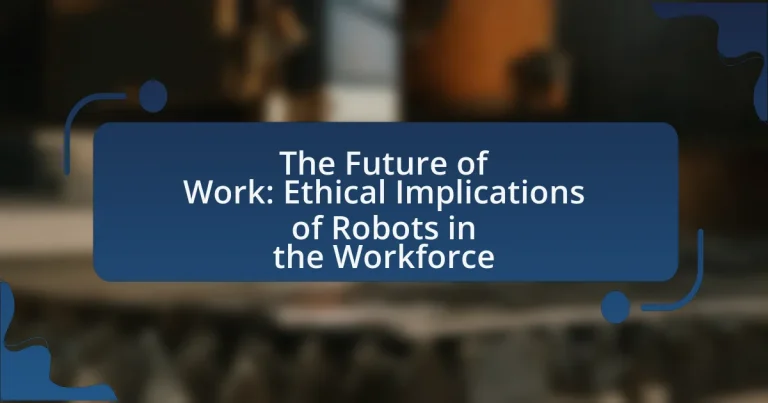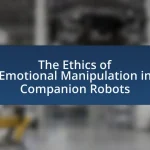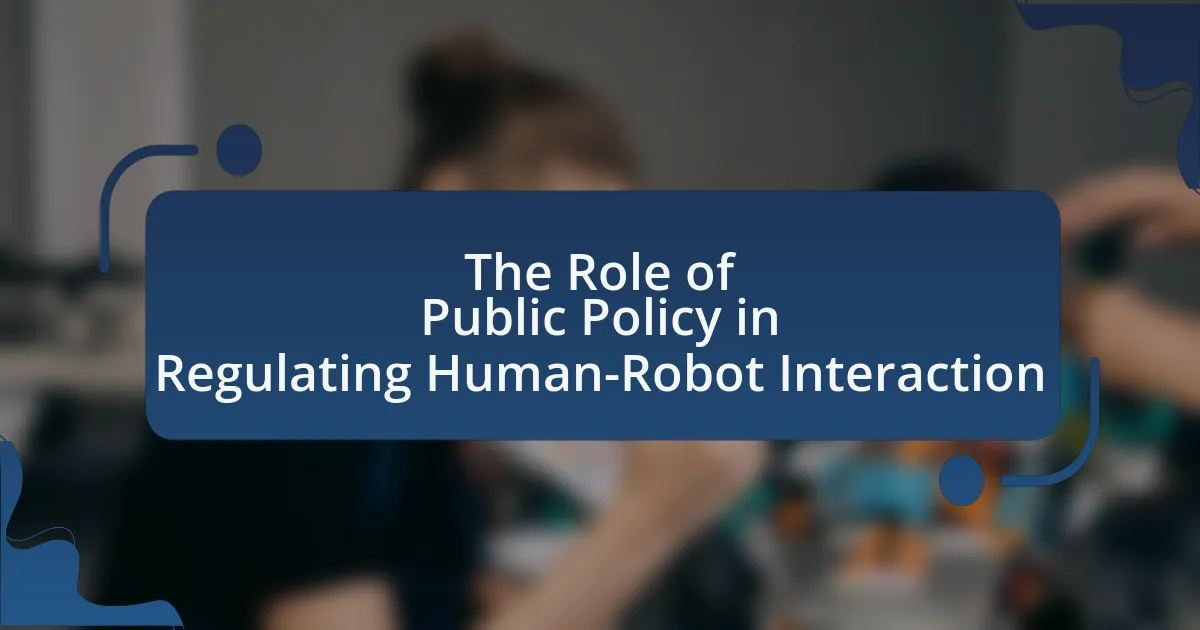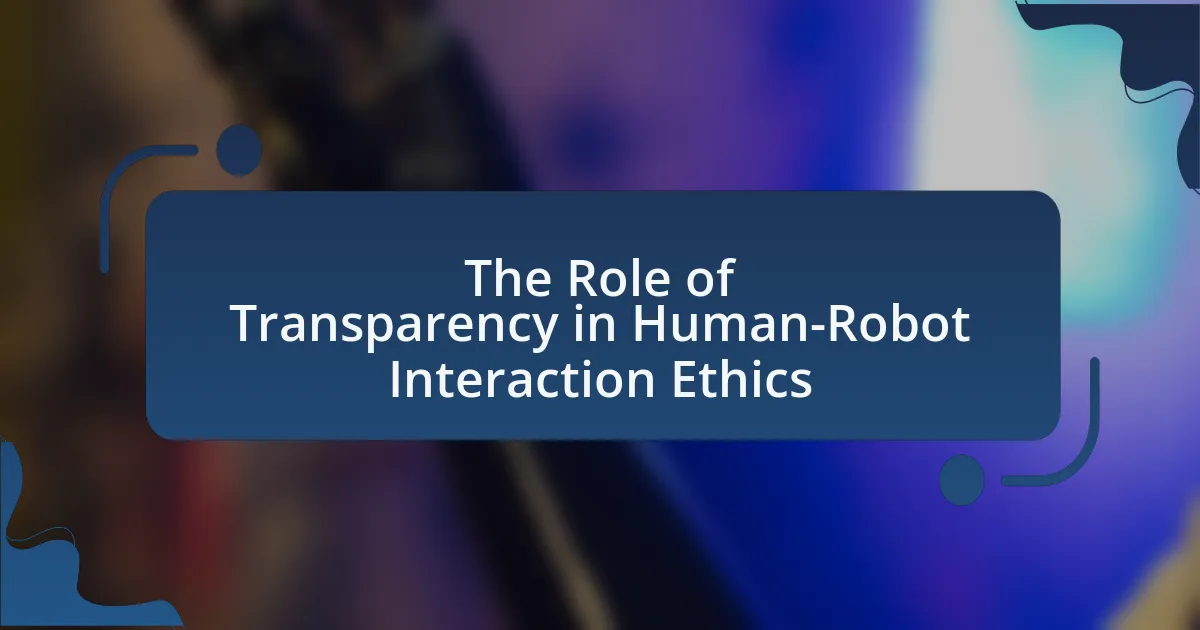The article examines the ethical implications of robots in the workforce, focusing on issues such as job displacement, privacy concerns, and accountability. It highlights the dual impact of automation on employment opportunities, noting that while certain jobs may be at risk, new roles are also expected to emerge. The discussion includes the types of jobs most vulnerable to automation, strategies for workforce adaptation, and the importance of ethical guidelines in robot integration. Additionally, the article addresses how businesses are responding to automation, the economic implications of robotic integration, and future trends in the workforce shaped by technological advancements.
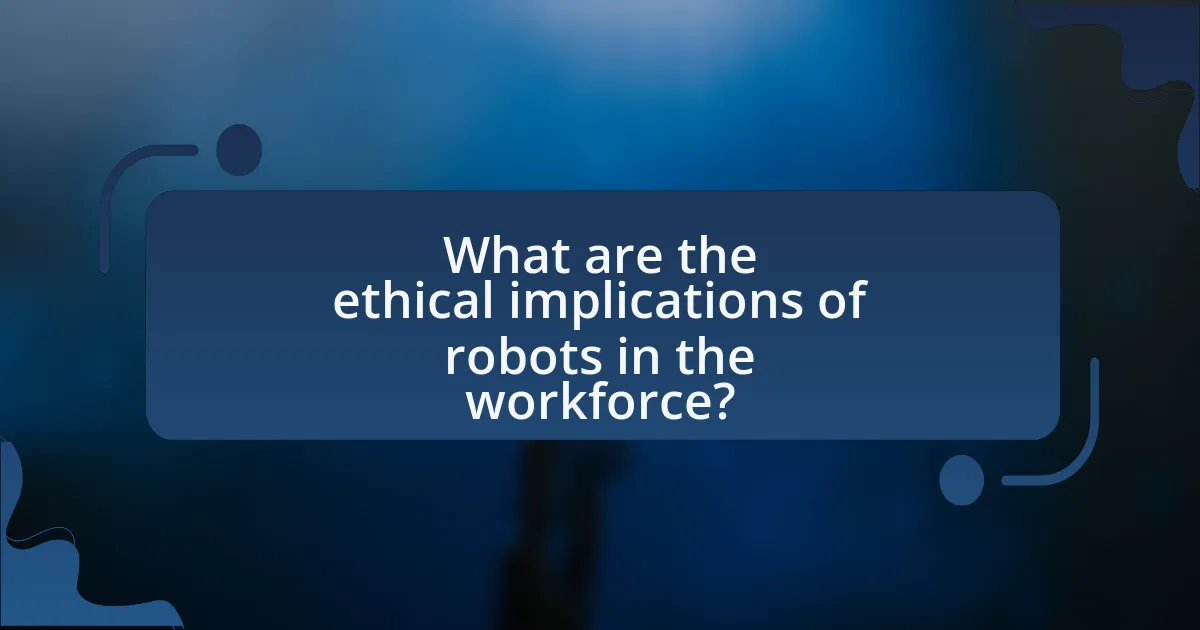
What are the ethical implications of robots in the workforce?
The ethical implications of robots in the workforce include job displacement, privacy concerns, and accountability issues. Job displacement occurs as automation replaces human labor, potentially leading to increased unemployment rates; for instance, a study by McKinsey Global Institute estimates that up to 800 million global workers could be displaced by automation by 2030. Privacy concerns arise from the data collection capabilities of robots, which can infringe on personal privacy and lead to misuse of sensitive information. Accountability issues emerge when robots make decisions that affect human lives, raising questions about who is responsible for errors or harm caused by automated systems. These implications necessitate careful consideration and regulation to ensure ethical integration of robots into the workforce.
How do robots impact employment opportunities?
Robots significantly impact employment opportunities by automating tasks, which can lead to job displacement in certain sectors while simultaneously creating new roles in others. For instance, a study by the McKinsey Global Institute estimates that by 2030, up to 800 million jobs worldwide could be displaced by automation, particularly in manufacturing and routine-based jobs. However, the same report indicates that automation could also create 555 million new jobs, particularly in technology, healthcare, and service industries, highlighting a shift in the types of employment available. This dual effect illustrates that while robots may reduce opportunities in some areas, they also foster growth in emerging fields, necessitating workforce adaptation and reskilling.
What types of jobs are most at risk due to automation?
Jobs most at risk due to automation include those in manufacturing, retail, and transportation. These sectors often involve repetitive tasks that can be easily performed by machines or software. For instance, a report by McKinsey Global Institute estimates that up to 800 million global workers could be displaced by automation by 2030, particularly in roles such as cashiers, assembly line workers, and truck drivers. The high potential for automation in these jobs is driven by advancements in robotics and artificial intelligence, which can enhance efficiency and reduce labor costs.
How can workers adapt to the changing job landscape?
Workers can adapt to the changing job landscape by continuously updating their skills and embracing lifelong learning. This approach is essential as technological advancements, particularly automation and artificial intelligence, are reshaping job requirements across various industries. According to a report by the World Economic Forum, 85 million jobs may be displaced by 2025 due to automation, while 97 million new roles could emerge that are more suited to the new division of labor between humans and machines. By engaging in reskilling and upskilling initiatives, workers can enhance their employability and remain relevant in a rapidly evolving job market.
What ethical concerns arise from robot integration?
Robot integration raises several ethical concerns, primarily related to job displacement, privacy, accountability, and bias. Job displacement occurs as robots automate tasks traditionally performed by humans, leading to unemployment and economic inequality. A study by the McKinsey Global Institute estimates that up to 800 million jobs could be lost globally by 2030 due to automation. Privacy concerns arise from the data collection capabilities of robots, which can infringe on individuals’ rights if not managed properly. Accountability issues emerge when robots make decisions that impact human lives, raising questions about who is responsible for those decisions. Additionally, bias in algorithms can perpetuate existing inequalities, as evidenced by research from MIT Media Lab, which found that facial recognition systems have higher error rates for people of color. These concerns highlight the need for ethical frameworks to guide robot integration in the workforce.
How do robots affect workplace safety and health?
Robots enhance workplace safety and health by reducing human exposure to hazardous tasks and environments. For instance, in manufacturing, robots can perform dangerous operations such as heavy lifting or working with toxic materials, thereby minimizing the risk of injury to human workers. A study by the International Federation of Robotics indicates that workplaces utilizing robots have reported a 20% decrease in workplace accidents. Additionally, robots can monitor environmental conditions, such as air quality and temperature, ensuring a safer working environment. This integration of robotics not only protects employees but also promotes overall health by reducing stress and fatigue associated with physically demanding jobs.
What are the privacy implications of using robots in the workplace?
The privacy implications of using robots in the workplace include potential surveillance of employees and the collection of personal data. Robots equipped with cameras and sensors can monitor employee behavior, leading to concerns about constant observation and loss of privacy. For instance, a study by the International Journal of Information Management found that 60% of employees felt uncomfortable with being monitored by workplace robots, indicating a significant privacy concern. Additionally, data collected by robots may be stored and analyzed, raising issues regarding data security and unauthorized access. This combination of surveillance and data collection can create an environment where employees feel their privacy is compromised, impacting workplace morale and trust.
What role does accountability play in robotic work environments?
Accountability in robotic work environments ensures that both human operators and robotic systems are responsible for their actions and decisions. This responsibility is crucial for maintaining safety, efficiency, and ethical standards in operations. For instance, when robots are programmed to perform tasks, accountability mechanisms must be in place to address errors or malfunctions, ensuring that human supervisors can trace decisions back to specific actions taken by the robots. Research indicates that clear accountability frameworks can enhance trust in robotic systems, as seen in studies where organizations implementing accountability measures reported a 30% increase in employee confidence regarding robotic assistance (Source: “Trust in Automation: A Review of the Literature,” by Lee et al., 2020). Thus, accountability not only fosters a safer work environment but also promotes a collaborative relationship between humans and robots.
Who is responsible for the actions of robots in the workplace?
The employer is primarily responsible for the actions of robots in the workplace. This responsibility arises from the legal and ethical obligations employers have to ensure that their operations, including the use of robotic systems, comply with safety standards and regulations. For instance, under the Occupational Safety and Health Administration (OSHA) guidelines, employers must provide a safe working environment, which extends to the integration of robotic technology. Additionally, liability can also extend to manufacturers of the robots if a defect in the design or function leads to harm. Therefore, both employers and manufacturers share responsibility, but the employer holds the primary duty to manage and oversee the robots’ actions in the workplace.
How can ethical guidelines be established for robot behavior?
Ethical guidelines for robot behavior can be established through a collaborative framework involving stakeholders such as ethicists, engineers, policymakers, and the public. This approach ensures that diverse perspectives are considered, leading to comprehensive guidelines that address various ethical concerns. For instance, the IEEE Global Initiative on Ethics of Autonomous and Intelligent Systems has developed a set of principles aimed at ensuring that technology aligns with human values, emphasizing transparency, accountability, and fairness. By integrating these principles into the design and deployment of robots, ethical standards can be systematically enforced, promoting responsible behavior in robotic systems.
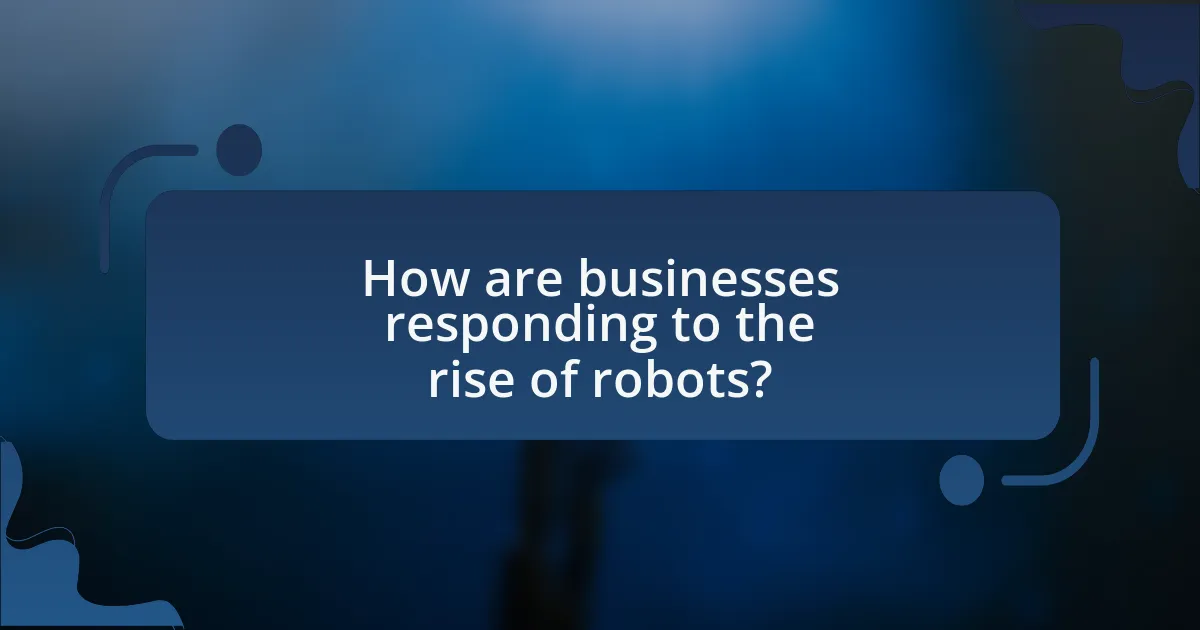
How are businesses responding to the rise of robots?
Businesses are increasingly adopting robots to enhance efficiency and reduce operational costs. Many companies are integrating automation technologies into their production lines, which has led to a significant increase in productivity; for instance, a McKinsey report indicates that automation could raise global productivity by 0.8 to 1.4 percent annually. Additionally, businesses are investing in training programs to upskill employees, ensuring they can work alongside robots effectively. This dual approach not only addresses labor shortages but also helps in maintaining a competitive edge in the market.
What strategies are companies implementing to integrate robots?
Companies are implementing several strategies to integrate robots into their workforce, including automation of repetitive tasks, collaborative robots (cobots) working alongside human employees, and investment in training programs for staff. Automation of repetitive tasks allows companies to enhance efficiency and reduce human error, as evidenced by a McKinsey report indicating that up to 45% of work activities could be automated using current technology. Collaborative robots are designed to assist human workers, improving productivity and safety in environments such as manufacturing and logistics. Furthermore, companies are investing in training programs to upskill employees, ensuring they can work effectively with robotic systems, which is crucial for maintaining a competitive edge in an increasingly automated landscape.
How do businesses balance automation with human employment?
Businesses balance automation with human employment by strategically integrating technology to enhance productivity while preserving jobs that require human skills. For instance, companies often automate repetitive tasks, allowing employees to focus on more complex responsibilities that demand creativity and critical thinking. According to a McKinsey report, up to 30% of work activities could be automated by 2030, but this shift also creates new job opportunities in tech and service sectors, emphasizing the need for workforce reskilling. By investing in employee training and development, businesses can ensure that their workforce adapts to technological changes, thus maintaining a balance between automation and human employment.
What training programs are being developed for workers alongside robots?
Training programs being developed for workers alongside robots focus on enhancing skills in collaboration, technology management, and problem-solving. These programs aim to equip workers with the necessary competencies to work effectively with robotic systems, emphasizing areas such as programming, maintenance, and data analysis. For instance, initiatives like the “Reskilling Revolution” by the World Economic Forum aim to provide training for millions of workers to adapt to new technologies, including robotics. Additionally, companies are increasingly investing in upskilling programs that incorporate hands-on training with robotic systems, ensuring that employees can leverage automation to improve productivity while maintaining job relevance.
What are the economic implications of robotic workforce integration?
Robotic workforce integration leads to significant economic implications, including increased productivity and potential job displacement. The introduction of robots in various industries enhances efficiency, as machines can operate continuously and perform tasks faster than human workers. For instance, a study by McKinsey Global Institute estimates that automation could raise global productivity growth by 0.8 to 1.4 percent annually. However, this shift may also result in job losses, particularly in routine manual and cognitive tasks, with the World Economic Forum projecting that 85 million jobs may be displaced by 2025 due to automation. Thus, while robotic integration can drive economic growth, it simultaneously poses challenges related to employment and workforce adaptation.
How does automation affect productivity and profitability?
Automation significantly enhances productivity and profitability by streamlining processes and reducing operational costs. By implementing automated systems, businesses can achieve higher output levels with fewer resources, leading to increased efficiency. For instance, a McKinsey report indicates that automation can boost productivity by up to 30% in certain sectors. Additionally, automation minimizes human error and accelerates production cycles, which directly contributes to higher profit margins. The World Economic Forum highlights that companies adopting automation technologies often see a substantial return on investment, further validating the positive correlation between automation, productivity, and profitability.
What are the potential long-term economic impacts of widespread robot use?
Widespread robot use is likely to lead to significant long-term economic impacts, including increased productivity, job displacement, and shifts in labor market dynamics. Increased productivity arises as robots can perform tasks more efficiently than humans, leading to higher output and potentially lower costs for goods and services. For instance, a study by McKinsey Global Institute estimates that automation could raise global productivity by 0.8 to 1.4 percent annually.
However, job displacement is a critical concern, as robots may replace human workers in various sectors, particularly in manufacturing and routine tasks. The World Economic Forum projects that by 2025, 85 million jobs may be displaced due to automation, while 97 million new roles could emerge, necessitating a workforce transition.
Additionally, the labor market may experience wage polarization, where high-skill jobs see wage increases while low-skill jobs decline, exacerbating income inequality. Research from the Brookings Institution indicates that automation disproportionately affects lower-income workers, potentially widening the economic gap.
Overall, the long-term economic impacts of widespread robot use encompass both opportunities for growth and challenges related to employment and inequality.
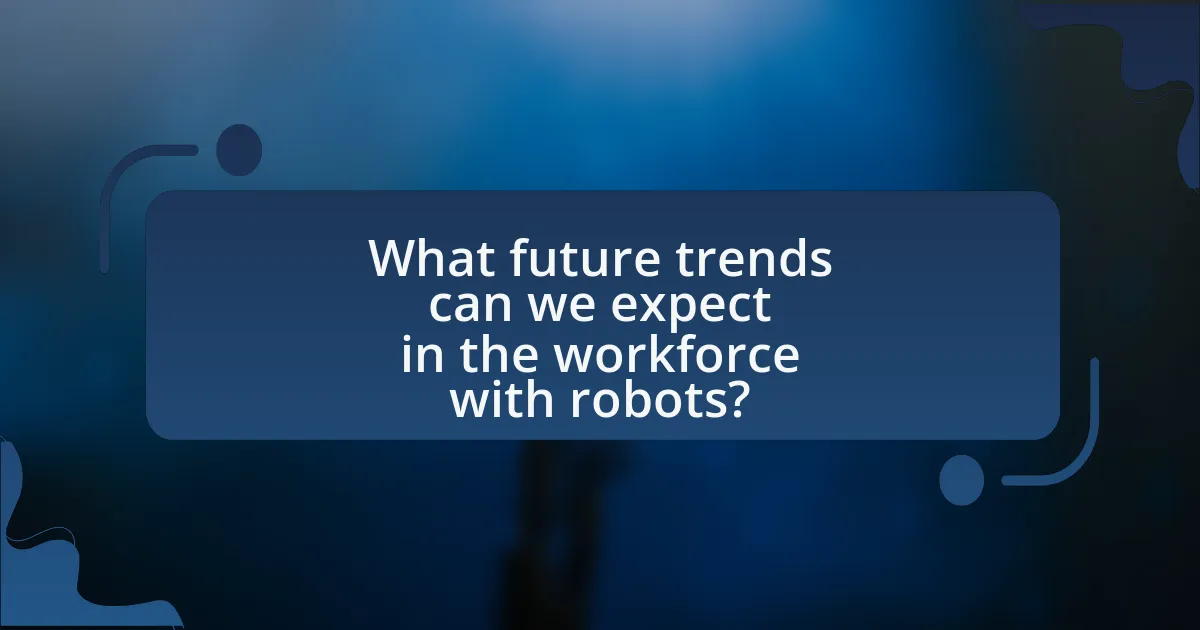
What future trends can we expect in the workforce with robots?
Future trends in the workforce with robots include increased automation, enhanced collaboration between humans and machines, and the emergence of new job categories. Automation is projected to take over repetitive and mundane tasks, allowing human workers to focus on more complex and creative responsibilities. According to a report by McKinsey, up to 800 million jobs could be displaced by automation by 2030, but simultaneously, new roles will be created, particularly in technology and robotics maintenance. Additionally, collaborative robots, or cobots, are expected to work alongside humans, improving productivity and safety in various industries. This shift will necessitate a workforce skilled in technology and adaptability, as highlighted by the World Economic Forum, which estimates that 85 million jobs may be displaced, but 97 million new roles could emerge by 2025 due to the rise of automation and AI.
How will advancements in technology shape the future of work?
Advancements in technology will significantly shape the future of work by automating tasks, enhancing productivity, and creating new job categories. Automation through artificial intelligence and robotics is expected to replace repetitive and manual jobs, leading to a shift in workforce demands. For instance, a report by McKinsey Global Institute estimates that by 2030, up to 375 million workers may need to switch occupational categories due to automation. Additionally, technology will facilitate remote work and flexible job arrangements, as seen during the COVID-19 pandemic, where companies adopted digital tools for collaboration. This transformation will require a focus on reskilling and upskilling the workforce to adapt to new technologies and roles.
What emerging technologies are influencing robotic capabilities?
Emerging technologies influencing robotic capabilities include artificial intelligence (AI), machine learning, advanced sensors, and the Internet of Things (IoT). AI and machine learning enable robots to learn from data and improve their performance over time, enhancing decision-making and adaptability. Advanced sensors provide robots with the ability to perceive their environment accurately, facilitating tasks such as navigation and object recognition. The IoT connects robots to networks, allowing for real-time data exchange and collaboration with other devices, which increases efficiency and functionality. These technologies collectively enhance the versatility and effectiveness of robots in various applications, from manufacturing to healthcare.
How might the role of humans evolve alongside robots?
The role of humans is likely to evolve into more supervisory, creative, and interpersonal functions as robots take over repetitive and manual tasks. As automation increases, humans will focus on areas requiring emotional intelligence, complex problem-solving, and innovation, which robots cannot replicate. For instance, a study by McKinsey Global Institute indicates that by 2030, up to 30% of the global workforce may need to transition to new roles due to automation, emphasizing the shift towards jobs that leverage human skills. This evolution will necessitate ongoing education and training to equip workers with the skills needed to thrive in a technology-driven environment.
What best practices should companies adopt for ethical robot integration?
Companies should adopt transparency, accountability, and inclusivity as best practices for ethical robot integration. Transparency involves clearly communicating the role and capabilities of robots to employees and stakeholders, ensuring that everyone understands how robots will impact their work. Accountability requires establishing guidelines and protocols for robot behavior and decision-making, allowing for oversight and responsibility in case of errors or ethical dilemmas. Inclusivity means involving diverse teams in the design and implementation processes, which helps to address potential biases and ensures that the technology serves the needs of all users. These practices are supported by research indicating that ethical considerations in technology deployment lead to better acceptance and outcomes in the workplace.
How can organizations ensure fair treatment of workers in automated environments?
Organizations can ensure fair treatment of workers in automated environments by implementing transparent policies that prioritize worker rights and engagement. Establishing clear guidelines for automation processes, including worker input in decision-making, fosters a sense of ownership and accountability. Research indicates that companies that involve employees in the transition to automation experience higher job satisfaction and lower turnover rates, as seen in a study by the International Labour Organization, which highlights the importance of worker participation in technological changes. Additionally, organizations should provide training and reskilling opportunities to help workers adapt to new roles created by automation, ensuring they remain valuable contributors to the workforce.
What frameworks can guide ethical decision-making in robotic deployment?
Ethical decision-making in robotic deployment can be guided by frameworks such as the IEEE Global Initiative on Ethics of Autonomous and Intelligent Systems, the Asilomar AI Principles, and the European Commission’s Ethics Guidelines for Trustworthy AI. The IEEE framework emphasizes the importance of ensuring that technology aligns with human values and societal norms, while the Asilomar principles focus on safety, transparency, and accountability in AI development. The European Commission’s guidelines advocate for AI that is lawful, ethical, and robust, ensuring that it respects fundamental rights and promotes well-being. These frameworks provide structured approaches to address ethical challenges in robotic deployment, ensuring responsible integration into the workforce.
